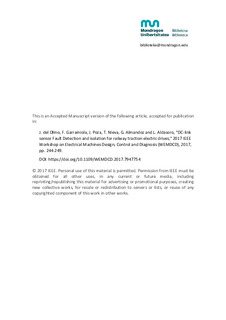
Izenburua
DC-link sensor Fault Detection and isolation for railway traction electric drivesBeste instituzio
Construcciones y Auxiliar de Ferrocarriles (CAF)Bertsioa
Postprinta
Eskubideak
© 2017 IEEESarbidea
Sarbide irekiaArgitaratzailearen bertsioa
http://doi.org/10.1109/WEMDCD.2017.7947754Non argitaratua
IEEE Workshop on Electrical Machines Design, Control and Diagnosis (WEMDCD) Nottingham. 20-21 April. Pp. 244-249. IEEE, 2017Argitaratzailea
IEEEGako-hitzak
Observers
fault detection
Mathematical model
Algorithm design and analysis ... [+]
fault detection
Mathematical model
Algorithm design and analysis ... [+]
Observers
fault detection
Mathematical model
Algorithm design and analysis
Rail transportation
Real-time systems [-]
fault detection
Mathematical model
Algorithm design and analysis
Rail transportation
Real-time systems [-]
Laburpena
This article presents the design and the implementation of a fault detection and isolation strategy for sensors in variable speed drives. Electric drives use several current and voltage sensors for co ... [+]
This article presents the design and the implementation of a fault detection and isolation strategy for sensors in variable speed drives. Electric drives use several current and voltage sensors for control and protection. The principal objective of the strategy is to detect faults in DC-Link sensors, since the conclusion of a preliminary study showed that in some applications many functionalities in the control strategy depend on it. Although it was mainly designed for DC-Link sensors, thanks to the FDI structure presented here, the algorithm is able to detect faults in other sensors. The strategy is based on state observers and has been validated through real time simulations in a Hardware-in-the-Loop platform. The principal components of the platform are an OPAL-RT real time simulator and a commercial traction control unit. [-]





















